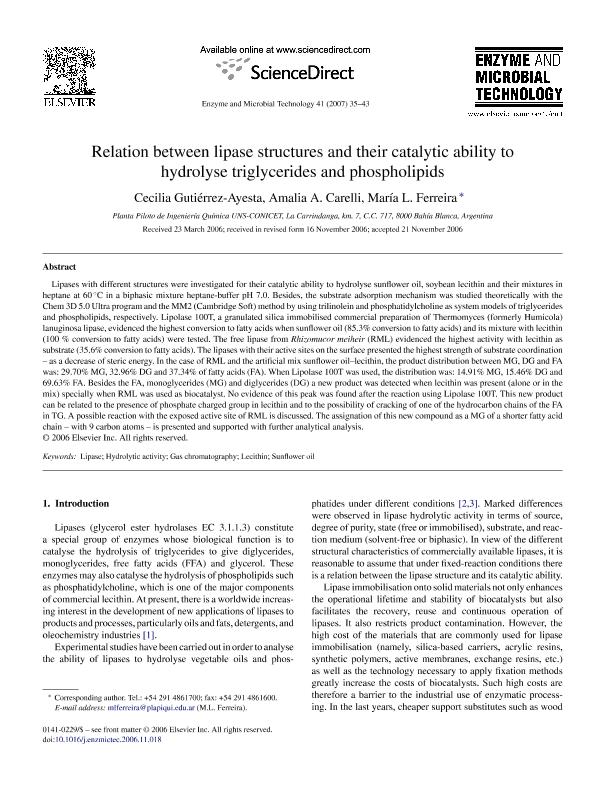Artículo
Relation between lipase structures and their catalityc ability to hydrolyse triglycerides and phospholipids
Fecha de publicación:
02/07/2007
Editorial:
Elsevier Science Inc
Revista:
Enzyme and Microbial Technology
ISSN:
0141-0229
Idioma:
Inglés
Tipo de recurso:
Artículo publicado
Clasificación temática:
Resumen
Lipases with different structures were investigated for their catalytic ability to hydrolyse sunflower oil, soybean lecithin and their mixtures in heptane at 60 °C in a biphasic mixture heptane-buffer pH 7.0. Besides, the substrate adsorption mechanism was studied theoretically with the Chem 3D 5.0 Ultra program and the MM2 (Cambridge Soft) method by using trilinolein and phosphatidylcholine as system models of triglycerides and phospholipids, respectively. Lipolase 100T, a granulated silica immobilised commercial preparation of Thermomyces (formerly Humicola) lanuginosa lipase, evidenced the highest conversion to fatty acids when sunflower oil (85.3% conversion to fatty acids) and its mixture with lecithin (100 % conversion to fatty acids) were tested. The free lipase from Rhizomucor meiheir (RML) evidenced the highest activity with lecithin as substrate (35.6% conversion to fatty acids). The lipases with their active sites on the surface presented the highest strength of substrate coordination – as a decrease of steric energy. In the case of RML and the artificial mix sunflower oil–lecithin, the product distribution between MG, DG and FA was: 29.70% MG, 32.96% DG and 37.34% of fatty acids (FA). When Lipolase 100T was used, the distribution was: 14.91% MG, 15.46% DG and 69.63% FA. Besides the FA, monoglycerides (MG) and diglycerides (DG) a new product was detected when lecithin was present (alone or in the mix) specially when RML was used as biocatalyst. No evidence of this peak was found after the reaction using Lipolase 100T. This new product can be related to the presence of phosphate charged group in lecithin and to the possibility of cracking of one of the hydrocarbon chains of the FA in TG. A possible reaction with the exposed active site of RML is discussed. The assignation of this new compound as a MG of a shorter fatty acid chain – with 9 carbon atoms – is presented and supported with further analytical analysis.
Palabras clave:
Lipase
,
Hydrolytic Activity
,
Gas Chromatography
,
Lecithin
,
Sunflower Oil
Archivos asociados
Licencia
Identificadores
Colecciones
Articulos(CCT - BAHIA BLANCA)
Articulos de CTRO.CIENTIFICO TECNOL.CONICET - BAHIA BLANCA
Articulos de CTRO.CIENTIFICO TECNOL.CONICET - BAHIA BLANCA
Citación
Gutiérrez Ayesta, Cecilia; Carelli Albarracin, Amalia Antonia; Ferreira, María Luján; Relation between lipase structures and their catalityc ability to hydrolyse triglycerides and phospholipids; Elsevier Science Inc; Enzyme and Microbial Technology; 41; 1-2; 2-7-2007; 35-43
Compartir
Altmétricas




